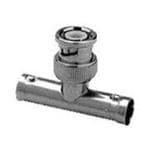Why do people never just plug things up and try! The physics above is sound. The advice accurate and sensible, but using a T piece to split one antenna to two receivers works amazingly well. 3 or 4dB is perfectly acceptable if you are not wanting to receive signals on the limits of the receiver's capability. I have in the workshop at the moment an SDR and a scanner connected to a single antenna with a hotchpotch of T pieces adaptors can cables for some testing I was doing, injecting signals from an RF generator to test rejection, and the SDR and scanner continued with all the usual stuff they work on. I turned the gain up on the SDR a smudge, but frankly, losses through all the connections are well within the limits, and I still hear all the stuff I usually listen to, with the exception of a distant marine shore station that only just lifted the squelch, and now it doesn't.
T pieces are cheap enough to have laying around being useful, and are worth trying. In professional comms systems there are all sorts of circulators and sniffers being used, let alone duplexers and filters and all of these things cause signal loss. If the signal is high enough, losing 3dB is quire livable. After all 2dB or less is generally accepted to be difficult to hear, benefits wise.
Do the split and try it out. If it works, use it. Radio is an experimentation hobby and all people do nowadays is hunt for youtube videos that are usually appalling or confusing.
Jimbo says in his first post he'd like to do something, and has the bits. If he uses them there will be loss. The only question should be - is the loss small enough to make the system work? He knows what he should hear, so plug it up and try it out. Do NOT be put off by gloom and doom. After all, if you plug it up and you cannot hear your favourite airfield or whatever, and that is important, you unplug it again. For goodness sake - this is not dangerous, not expensive and it's exactly what you do to improve your own knowledge.
Of course, the physics is important - but you won't learn without trying things.
Sorry for being so grumpy - but this is an excellent practical thing to just try, not prevaricate about. Tell us the results and that will be really helpful for everyone - what were the downsides, and what was good about it? That's genuinely useful info.



